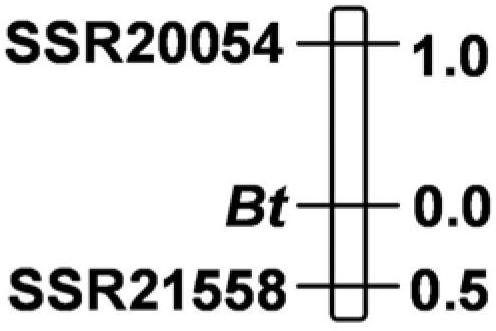SSR (Simple Sequence Repeat) marker tightly interlocked with cucumber fruit bitter gene Bt and application thereof
A technology of fruit bitterness gene, SSR21558-F, which is applied in application, plant genetic improvement, microbial measurement/inspection, etc. It can solve the problems of tediousness, inability to carry out precise grading, and inaccurate results.
- Summary
- Abstract
- Description
- Claims
- Application Information
AI Technical Summary
Problems solved by technology
Method used
Image
Examples
Embodiment 1
[0031] Example 1. Screening of cucumber fruit bitterness gene Bt-linked SSR markers
[0032] Step 1. Identification of Cucumber Fruit Bitterness
[0033] The cucumber materials for testing were sown and raised on March 14, 2010, and planted in the spring greenhouse of the Institute of Vegetables and Flowers, Chinese Academy of Agricultural Sciences on April 16. planting parent and F 1 30 plants each (3 replicates, 10 plants per replicate), F 2 189 strains. Seedling routine management. After planting, the night temperature in the early stage is controlled below 12°C, and the daytime temperature in the later stage is higher than 32°C. Water is controlled throughout the growth period, and nitrogen fertilizer is added to induce the full expression of bitterness genes. Referring to the method of Li Xingfang et al. (2004), the fruit bitterness was identified by mouth tasting. From the root melon to the end of the test (1 growing season), if each plant has bitter taste 4 times, ...
Embodiment 2
[0066] Example 2. Verification of Bt gene double-flanked SSR markers
[0067]Using 20 cucumber materials of different ecological types collected in this project, the markers closely linked to both sides of the Bt gene were verified to determine the accuracy of the markers SSR21558 and SSR20054 for molecular marker-assisted selection. The phenotypes of these 20 individual plants are: 18 fruit are not bitter; 2 fruit are bitter. The analysis results using the marker SSR21558 showed that the target bands were amplified in all 20 materials, and compared with the field phenotype, the detection accuracy was 95.0%. Another marker linked to the Bt gene, SSR20054, was used to verify the above materials, and the target band was amplified in 20 copies of DNA. Compared with the field phenotype, the detection accuracy rate was 75.0%, and the two markers were used to confirm each other. The verification accuracy can reach 95.0%.
[0068] In this study, the SSR linkage map of the cucumber ...
PUM
 Login to View More
Login to View More Abstract
Description
Claims
Application Information
 Login to View More
Login to View More - R&D
- Intellectual Property
- Life Sciences
- Materials
- Tech Scout
- Unparalleled Data Quality
- Higher Quality Content
- 60% Fewer Hallucinations
Browse by: Latest US Patents, China's latest patents, Technical Efficacy Thesaurus, Application Domain, Technology Topic, Popular Technical Reports.
© 2025 PatSnap. All rights reserved.Legal|Privacy policy|Modern Slavery Act Transparency Statement|Sitemap|About US| Contact US: help@patsnap.com



